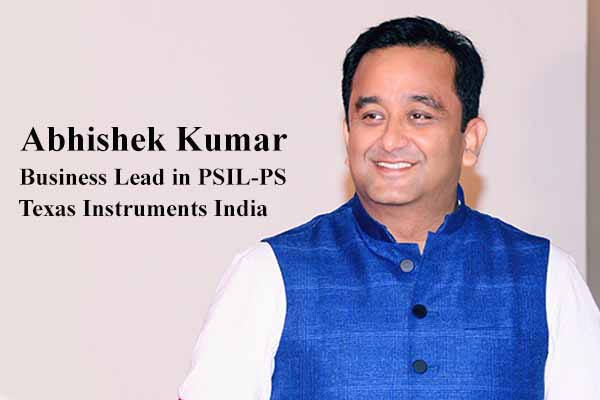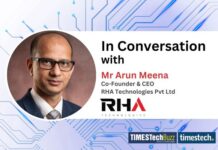Semiconductors has increased efficiency and reduced the size of devices. Although use of semiconductors started much earlier but real reduction in the size of electronic devices became possible only after introduction of Power Integrated Circuits. So, TimesTech brings you Abhishek Kumar, Business Lead in PSIL-PS, Texas Instruments India to answer some basic questions about power Power Integrated Circuits and tell us about the new appplications and developments in the Power Integrated Circuits.
TimesTech: What are the applications of Power Integrated Circuits?
Abhishek: Power Integrated circuits are Integrated circuits that are capable of driving a power load. The key feature of a power integrated circuit that differentiates it from other semiconductor technologies is its ability to handle the high voltage, high current, or a combination of both. Today, a large class of applications is emerging in the low to high power levels where power ICs are used to provide an advantage in size and cost per function. Power integrated circuits are expected to have an impact on all areas in which power semiconductor devices are presently being used. In addition, they are expected to open up new applications based on their added features. These include switch mode power supplies, motor controllers, automotive electronics, industrial automation, enterprise servers, and personal electronics.
TimesTech: How did the MOSFET provide the link between power devices and integrated circuits?
Abhishek: MOSFETs are the most common semiconductor devices in digital and analog circuits. They are also the most common power devices. Discrete or integrated MOSFET devices are widely used in applications such as switch mode power supplies, variable-frequency drives, and other power electronics applications where each device may be switching from a few watts to thousands of watts of power.
The power MOSFET is the most widely used power device in the world. Advantages over bipolar junction transistors in power electronics include MOSFETs not requiring a continuous flow of drive current to remain in the ON state, offering higher switching speeds, lower switching power losses, lower on-resistances, and reduced susceptibility to thermal runaway. The power MOSFET had an impact on power supplies, enabling higher operating frequencies, size and weight reduction, and increased volume production.
TimesTech: What are some of the new innovations happening in power integrated circuits?
Abhishek: Power IC devices are used in almost all electric and electronic systems with different requirements for each application. There are key innovations taking place in different aspects of power management in order to push the current envelope and meet upcoming trends and requirements. For example, new innovations are happening in improving power density to achieve more power in smaller spaces and enhancing system functionality at a reduced system cost. TI’s latest power protection device TPS25981 is able to deliver 160W in a 4mm2 package. Another critical innovation that’s happening is in improving the quiescent current of power devices to extend battery and shelf life without compromising system performance in battery-operated systems like smoke detectors, health monitors, wearables, IoT applications, etc.
The automotive segment is the most promising for the power IC market in terms of forecasted volumes. This is driven by electrification and autonomous driving, and one of the key innovations is happening in Isolation techniques to transfer signal and power across a high-voltage isolation barrier to increase safety with the highest working-voltage and reliability.
TimesTech: How has the demand for EVs and Energy Storage affected innovation in power integrated circuits?
Abhishek: Electric vehicles (EVs) and Energy storage are experiencing a rise in popularity over the past few years as the technology has matured and costs have declined. Support for clean transportation has promoted awareness, increased charging opportunities, and facilitated EV adoption. One of the key topics of on-board chargers and EV charging stations is electric vehicles and their impact in the power distribution systems requires new innovations to create sustainable solutions. EV charging needs to be quick, affordable, safe and robust which makes Gallium nitride (GaN) a popular topic in the power electronics industry to achieve higher power density and efficiency, and multiple innovations that are happening across the globe on this technology. Bi-directional charging will allow consumers to send surplus power back to the grid as well as looking at other renewable energy sources and innovation in these areas will be fueled by the advancement of EVs in the market. As automakers consider new EV battery chemistries, battery management systems (BMS) with advanced power semiconductor technologies are more critical than ever. More BMS innovations are coming up in the high precision battery monitors and protection areas. Companies are pushing the boundaries of voltage accuracy and are integrating more control capabilities into each IC to solve customers’ challenges.
TimesTech: What are the current challenges with respect to Power Integrated Circuits?
Abhishek: Power electronic devices are expected to play an ever more fundamental role in unlocking the potentialities of smart power systems, thanks to innovative devices such as SiC and GaN-based power switches, and to new topologies. However, the exploitation of such opportunities imposes some challenges, mainly due to power density increase, cost reduction, electromagnetic compatibility, and converter optimization.
Advanced Power Electronic systems will challenge the power quality and EMC of the power grid in both the low and high (>150kHz) frequency ranges. To meet international standards, the output filter damping needs to be increased and this will adversely affect power grid impedance making it more prone to instability and incompatibility issues. Thus, there will be a need for more advanced control and impedance shaping strategies to maintain grid performance.
Increasing integration at the component, converter, and system-level demands new concepts to address challenges in thermal, insulation, testing, manufacturing, packaging, and cost reduction. Life cycle analysis, including recycling to ensure the sustainability of power electronic products, is of increasing importance.
A wave of digitalization possibilities is emerging due to increased connectivity and handling of big data and throws a challenge of integrating high power conversion and digital interface in the same die and package.
TimesTech: How do you view the market for Power Integrated Circuits?
Abhishek: There’s a major trend in the marketplace to add energy efficiency and lower footprint to electronics of every shape and size. There are also new regulations for electronic products to meet new efficiency standards. As a result, we are seeing a global demand for the next generation of power semiconductors to meet more stringent efficiency, size and power consumption requirements. As the power consumption of data-center applications grows in relation to the total electrical power consumption, data-center architectures rely on high-efficiency designs. Innovations in power electronics drive more electric aerospace applications such as hydraulic networks with more or full electric engines. In electric vehicles, power devices are used in energy storage, electric drive and power conversion, interior, thermal, powertrain, and chassis. EV adoption presents a high-volume opportunity for power electronics. It’s expected to grow to a $3B market by 2022. All these exciting changes and needs make the market for power Integrated circuits very attractive.















